Core strength training may be a relatively new, buzz term in the fitness industry but coaches and athletes have understood its value for many years.
The core region consists of far more than just the abdominal muscles. In fact core strength training aims to target all the muscles groups that stabilize the spine and pelvis.
It’s these muscle groups that are critical for the transfer of energy from large to small body parts during many sporting activities.
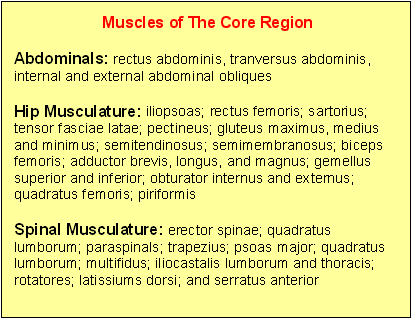
Core Strength Training For Athletic Performance
The muscles of the trunk and torso act to stabilize the spine, pelvis and shoulder girdle. From this solid, balanced base the limbs can be moved powerfully and under control. In fact before rapid movements of the extremities can take place, the central nervous system stabilizes the spine in anticipation (1). The rate at which the core muscles stabilize the spine may have a direct effect on the power of limb movement (2).
Core strength training differs from many traditional weight training routines by working both the lower back and abdominals in unison. The same is true for the upper and lower body. All athletic movements incorporate the core in some way. Very few muscle groups are isolated. Instead the whole body works as a unit and core strength training endeavours to replicate this.
What are the benefits of core strength training to the athlete?
- Greater efficiency of movement
- Improved body control and balance
- Increased power output from both the core musculature and peripheral muscles such as the shoulders, arms and legs
- Reduced risk of injury (the core muscles act as shock absorbers for jumps and rebounds etc.)
- Improved balance and stability
- Improved athletic performance!
Core Strength Training For Reducing Back Problems & Injuries
Weak or poorly controlled core muscles have been associated with low back pain (3,4). The back muscles are responsible for movements such as extension and flexion of the spine and rotation of the trunk.
Excessive or uneven shock on the spine may lead to back problems. This may be exaggerated because weak core muscles lead to improper positioning or a forward tilt. In many exercises that use the back muscles, the abdominal muscles contract isometrically stabilizing the body.
The stronger and more correctly balanced the core muscles are, the less the uneven strain on the spine.
Core Strength Training To Get a Six Pack
If you’ve visited the abdominal training section of the site, you’ll already appreciate that getting those wash board abs requires a different approach than simply crunching out lots of sit ups. Also remember that core strength training is NOT about focusing purely on your abs.
If you want a six pack, then yes, core strength exercises should predominate in your routine. Not because they blast your ab muscles, they don’t. But they will help you to reduce your body fat stores and increase the muscularity of your rectus abdominus and they will give you the most returns for your efforts.
You will still need to focus on your diet and it won’t do any harm adding a few ab-specific exercises like crunches and leg raises within your sessions.
Equipment Used For Core Strength Training
While there are no doubt countless gimmicks on the market purporting to strengthen the core region most are useless to the athlete.
There are however, several pieces of exercise equipment that are genuinely useful for strengthening the core region. They include…
- Medicine Balls
- Stability Balls
- Balance Boards
These simple pieces of equipment allow the coach or athlete to devise resisted sport-specific movements. Medicine balls are particular helpful for mimicking rotation movements for example that would be unpractical with free weights.
Of course even these pieces of equipment are not essential. There are many exercises that use bodyweight or partner resistance that strengthen the core effectively. The use of free weights can adapted to cater for the majority of athletic movements.
Popular Core Strength Training Exercises
Prone Bridge
In a face down position, balance on the tips of your toes and elbows while attempting to maintain a straight line from heels to head. This exercise focuses on both the anterior and posterior muscle groups of the trunk and pelvis.
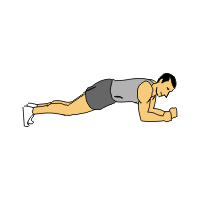
Lateral Bridge
Start on your side and press up with your right arm. Form a bridge maintaining a straight line from your hand to your foot. Rest on your elbow to increase the difficulty. This exercise focuses on the abdominal obliques and transversus abdominus.
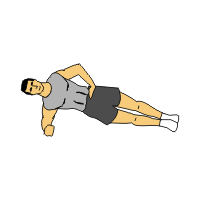
Supine Bridge
Lying on your back, raise your hips so that only your head, shoulders, and feet are touching the floor. The supine bridge focuses on the gluteal muscles. Stronger gluteals help maintain pelvic control.
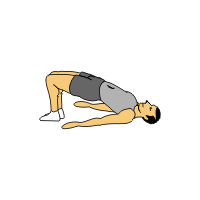
Pelvic Thrusts
Lie on your back with your legs bent 90 degrees at the hip. Slowly lift your hips off the floor and towards the ceiling. Lower your hips to the floor and repeat for the prescribed number of repetitions.

Russian Twists
1. Start by sitting on the floor with hips and knees flexed to approximately 90 degree angles.
2. Grasp a medicine ball or small dumbbell and swing it to the right and left as you keep the hips from rotating with the shoulders.
3. The arms are not perpendicular to the torso, but instead, kept low, near the thighs, as the medicine ball is swung to each side.

Good Mornings
1) Stand with feet shoulder width apart with knees slightly bent (at 20).
2) Start position: Grasp bar with overhand grip shoulder width apart. Back should be straight in a neutral position.
3) Bending at the hips, lower bar to approximately knee height. Keep knees bent at 20 throughout movement.
4) Return to start position.
5) Remember to keep back straight – movement should occur at the hip. To facilitate this, shift glutes back as if ready to sit down. Knees should not move forward beyond the toes.

Dumbell Lunges with Crossover
1) Start position: Stand with feet hip width apart. Grasp DB’s and hold out in front of body.
2) Step forward 2-3 feet forming a 90 bend at the front hip and knee. DO NOT allow front knee to extend past the big toe – may cause injury. As you are lunging swing dumbbells across body towards the hip.
3) Pushing off front foot, return to start position with legs and dumbbells.
4) Remember to keep head and back upright in a neutral position. Shoulders and hips should remain squared at all times.
5) Watch for proper knee alignment – do not let front knee extend past big toe or deviate laterally or medially. Back knee should not come in contact with floor.
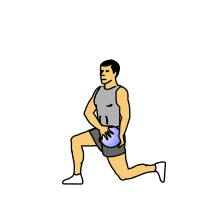
Other excellent core stability exercises include:
- Lat Pull Downs
- Leg Presses/Squats
- Crunches and crunch variations
- Regular lunges
- Back extensions
- Deadlifts
- Chin-ups
- Medicine ball exercises
References for Core Strength Training
1) Hodges PW, Richardson CA. Contraction of the abdominal muscles associated with movement of the lower limb. Phys Ther. 1997 Feb;77(2):132-42; discussion 142-4
2) Hodges PW, Richardson CA. Relationship between limb movement speed and associated contraction of the trunk muscles. Ergonomics. 1997 Nov;40(11):1220-30
3) Hodges PW, Richardson CA. Inefficient muscular stabilization of the lumbar spine associated with low back pain. A motor control evaluation of transversus abdominis. Spine. 1996 Nov 15;21(22):2640-50
4) Hodges PW, Richardson CA. Altered trunk muscle recruitment in people with low back pain with upper limb movement at different speeds. Arch Phys Med Rehabil. 1999 Sep;80(9):1005-12

Jacky has a degree in Sports Science and is a Certified Sports and Conditioning Coach. He has also worked with clients around the world as a personal trainer.
He has been fortunate enough to work with a wide range of people from very different ends of the fitness spectrum. Through promoting positive health changes with diet and exercise, he has helped patients recover from aging-related and other otherwise debilitating diseases.
He spends most of his time these days writing fitness-related content of some form or another. He still likes to work with people on a one-to-one basis – he just doesn’t get up at 5am to see clients anymore.